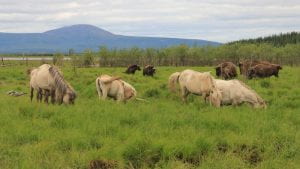Research in Bioengineering
An Ethical Analysis of the De-extinction of the Woolly Mammoth
By Carson M Longendorfer
During my time studying Bioengineering at UMass Dartmouth I have learned a lot about the vast potentials of biotechnology. I recall one topic that really struck a chord with me from my BIO 121 class, de-extinction. The professor described to us how a researcher in Australia, had brought the southern gastric brooding frog back from extinction in his lab by using the same technology that made Dolly the sheep a reality. He also briefly mentioned to us that another research group, wanted to use de-extinction to bring an ancient ice age species, the woolly mammoth, back into the wild. I was compelled to read up on this a little more and I learned that the project is lead Dr. George Church at Harvard University who is helping to develop the genetic editing technology known as CRISPR/Cas 9 (Shapiro, Beth). Using this technology he is attempting to swap out pieces of the genome of a somatic elephant cell until it resembles that of a woolly mammoth (Shapiro, Beth). This cell would then be implanted into an elephant embryo and carried to term by an elephant until the mammoth is born (Shapiro, Beth). I found this to be a really interesting use of biotechnology as well an intriguing ethical question, I was inspired. I became interested in further delving into the ethical implications of de-extinction, and so, I was very excited to learn about the summer grant opportunity from the OUR.
Portrait of Carson M Longendorfer
I decided to take a two-pronged approach in my research, first analyzing the scientific justifications and oppositions and secondly the philosophic implications that the de-extinction of the woolly Mammoth poses. One of the major justifications for Church’s project is its potential benefits to the environment. Sergey Zimov hypothesized that the changes to the environment during the transition from the pleistocene to the holocene era did not cause the mass extinctions that included the woolly mammoth but instead, It was the extinctions that caused the environmental changes (Zimov, S. A.). He was able to support this hypothesis by fencing off an area in Siberia and relocating a few species of large herbivores. The herbivores eat the grass and stimulate the growth of more completely transforming the swamp to grasslands within one year (Zimov, S. A.). Grasslands are preferable to wetlands because wetlands release greenhouse gases into the atmosphere causing global warming and when the wetlands are fed by the melting of the permafrost underneath, this could be very bad for the environment (Shapiro, Beth). Zimov wants to expand the experiment that he calls Pleistocene Park to cover a large area of Siberia and to include the woolly mammoth (Zimov, S. A.). The mammoth is especially good for this purpose because of its large size, it tramples the snow which acts as an insulator keeping the ground warmer (Shapiro, Beth). By disturbing the snow, it allows for more cold air to reach the permafrost keeping it more frozen (Shapiro, Beth).

Pleistocene Park, Russia. Photograph courtesy of The Telegraph.
In this way, a compelling Utilitarian argument can be made because the suffering of a few elephants as well as the objectification of the hybrid mammoth can be justified for the benefit of the entire planet and every species on it. Environmental ethicist, Robert Elliot claims that nature cannot be restored after having been damaged because original nature has an intrinsic value that can’t be regained because it can never be the same as it was (Elliot, Robert). Therefore, the only real way to preserve nature is to stop causing further damage and using de-extinction as a restoration method is unhelpful and even more damaging (Elliot, Robert).
§
I plan to submit my research to the Penn Bioethics Journal, a peer-reviewed journal for undergraduates. I am grateful for the opportunity that the OUR has provided for me and I hope that this experience with bioethics research is only the beginning of a successful future career as a bioethicist.
References
Elliot, Robert. Faking Nature: The Ethics of Environmental Restoration. London: Routledge, 2007.
The Telegraph Editorial. “Is Jurassic World closer than we think?” The Telegraph, Telegraph Media Group, 3 Sept. 2015, www.telegraph.co.uk/film/jurassic-world/pleistocene-park-dna-dinosaurs/. Accessed 29 Aug. 2017.
Shapiro, Beth. How to Clone a Mammoth: The Science of De-extinction. Princeton: Princeton University Press, 2016.
Zimov, S. A. “Essays on Science and Society: Pleistocene Park: Return of the Mammoths Ecosystem.” Science 308, no. 5723 (2005): 796-98. doi:10.1126/science.1113442.


